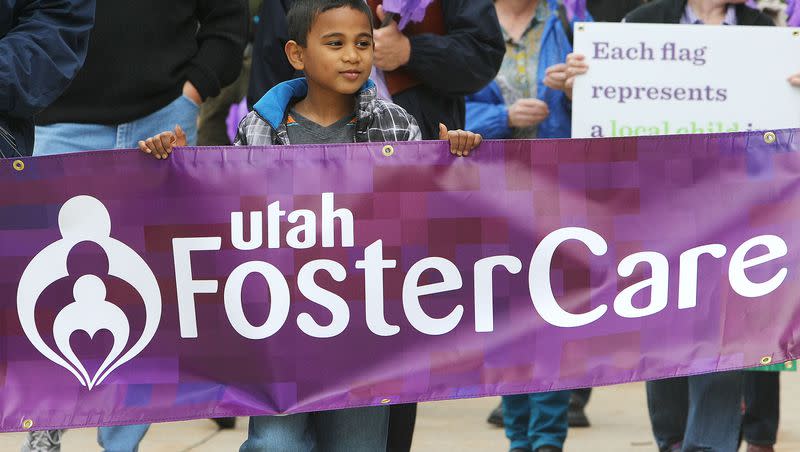Perspective: Utah is leading the way in caring for foster children

Late last year, Utah Gov. Spencer Cox announced that he wanted the Beehive State to be the first in the country to have a waiting list for parents seeking to foster and adopt, as opposed to a list of children in care waiting for foster parents or adoptive homes. Putting his money where his mouth is, Cox proposed a 50% increase in payments for foster care and kinship placements.
It’s certainly a positive sign that the governor is prioritizing the most vulnerable kids in the state, but it turns out that Utah’s child welfare professionals and family courts are prioritizing the safety and well-being of these kids in ways that are much more significant.
According to a new American Enterprise Institute report that ranks states by how quickly they move children out of the foster care system (either to reunite them with their families or to find them adoptive placements with another family), Utah is No. 1 in the country.
There are more than 390,000 children in the U.S. foster care system, typically due to chronic and/or severe abuse or neglect. States are supposed to prioritize permanency for children in foster care. This means that states first try to help the family fix the factors leading to loss of custody so the child can safely go home. If those efforts are unsuccessful, the state finds a safe and appropriate permanent home for the child through adoption or guardianship.
In 1997, a bipartisan majority in Congress passed the Adoption and Safe Families Act to ensure that states did not keep children in foster care indefinitely when reunification efforts were not working. But the law included broad exceptions and little in the way of enforcement mechanisms. In the years since, many states have all but ignored it — choosing instead to either repeatedly reunify children with parents who could not care for them or let children stay in foster care for years. Now a number of advocates want to repeal the law entirely, suggesting that any timeline is unfair to parents who are victims themselves of poverty, racism or other structural factors.
Related
Without permanency, however, children have no legally or socially recognized family. They can be uprooted at any time, with little warning. Children don’t know where and to whom they belong, and this uncertainty inhibits the development of healthy relationships and discourages planning for the future. Living in this kind of limbo for years at a time makes it more likely that kids will not finish school or find gainful employment or that they may turn to drugs or criminal activity. Minimizing this period of uncertainty by providing timely permanency is among the most important functions of the child welfare system.
Utah is one of a handful of states that appears to consistently prioritize timely permanency. This report, which is based on an analysis of more than 782,000 children entering foster care up to age 14, looks at foster care entries between October 2014 and March 2018. Children were followed until they exited care or spent three full years in continuous state custody. The most recent data available at the time of the analysis were from March 2021.
The rankings took four factors into account: 1) Timely exits to permanency, 2) Timely permanency for children who have not been reunified, 3) Application of ASFA principles, and 4) Failed reunifications. Utah received the highest score on the first three factors, and an above-average ranking on the last.
One item that tipped the scales was the state’s time to adoption. More than 61% of Utah infants who could not be reunified were adopted within 18 months, compared with fewer than 15% nationally. And the state has almost no young children in foster care longer than three years.
Even among older children, where many states all but give up on the possibility of adoption, Utah vastly outperforms national averages.
These outcomes are not the result of factors that many observers might imagine influence the workings of a child welfare system. For instance, Utah does have a relatively high level of average household income, a high percentage of its population educated and a high percentage who are white. But so do Connecticut, New Hampshire and Massachusetts, which rank 45th, 46th and 48th, respectively. When kids are left in foster care for years at a time, it is not the result of funding, the relative wealth of families, or even whether the state is led by a Republican or a Democrat. Utah’s secret to success appears to be quite simple: the state has clear and enforceable policies that treat permanency as an urgent need for every child.
Many argue that applying the timelines of the Adoption and Safe Families Act closes the door on reunification when there is no alternative — leaving children as “legal orphans” with no prospects of adoption. But Utah is one of few states that has really leaned into the strategy of the Adoption and Safe Families Act. And they are not just terminating parental rights and then letting kids stay in foster care indefinitely. They are actually finding safe and appropriate adoptive homes for them.
There is always more work to be done to improve the lives of kids who are abused and neglected, but Utah seems to be leading the way.
Sarah Font is an associate professor of sociology and public policy at Penn State. Naomi Schaefer Riley is a senior fellow at the American Enterprise Institute and the author of “No Way to Treat a Child: How the Foster Care System, Family Courts and Racial Activists Are Wrecking Young Lives.”

